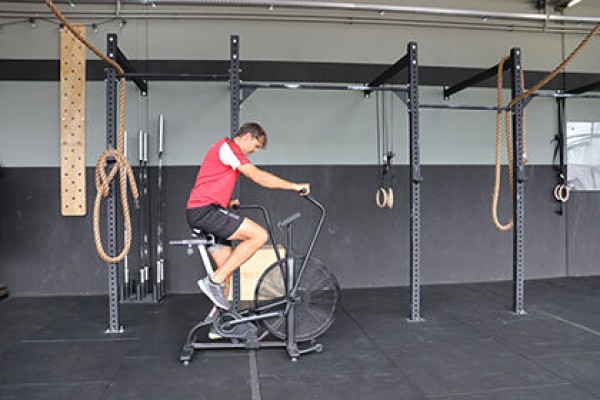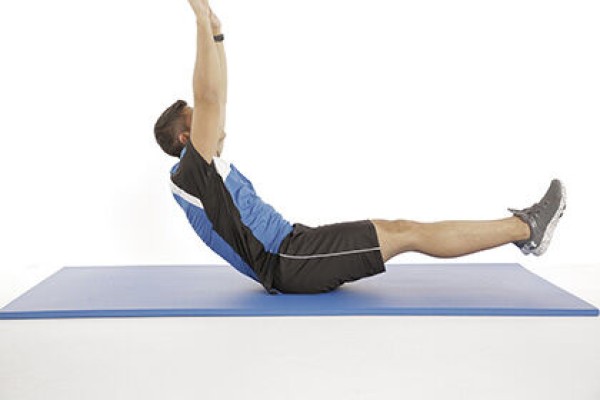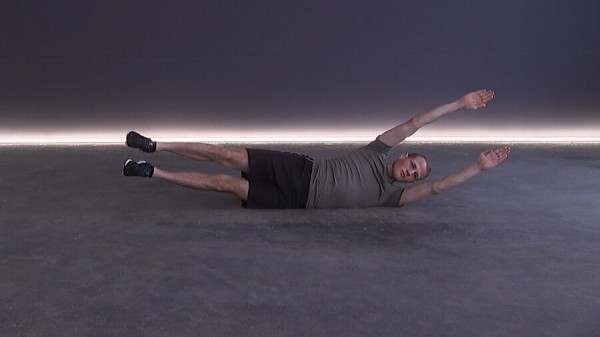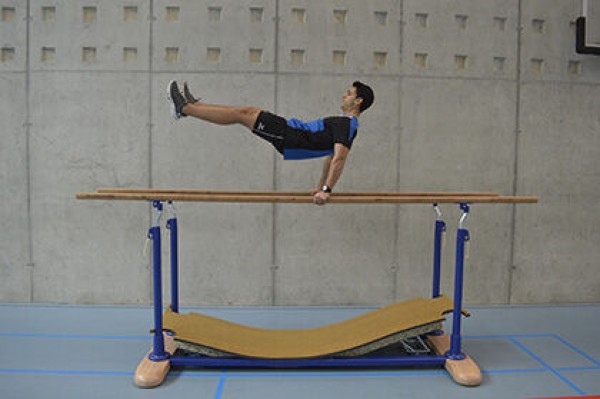Exercises (1775)
Air-Bike (m: 250m - 7k; f: 200m - 5k)
Power
Individual work


At first glance, the air bike looks similar to a bicycle ergometer or a spinning bike. However, the difference lies in the fact that not only the legs but also the arm and core muscles are used, as these are required for the movement of the air bike. As the handles are pulled along with the hands, the legs and arms move simultaneously.
As the name suggests, the special feature of the air bike is the air resistance. The intensity of the training is regulated solely by the air resistance. The faster the pedalling movement, the greater the air resistance, and therefore the more strenuous the training. On the one hand, this ensures intuitive operation of the device, which is an additional fun factor for many athletes, and on the other hand, the air resistance ensures that the joints are protected.
1 Air-Bike
Air-Bike (m: 300m - 10k; w: 250m - 6k)
Power
Individual work


At first glance, the air bike looks similar to a bicycle ergometer or a spinning bike. However, the difference lies in the fact that not only the legs but also the arm and core muscles are used, as these are required for the movement of the air bike. As the handles are pulled along with the hands, the legs and arms move simultaneously.
As the name suggests, the special feature of the air bike is the air resistance. The intensity of the training is regulated solely by the air resistance. The faster the pedalling movement, the greater the air resistance, and therefore the more strenuous the training. On the one hand, this ensures intuitive operation of the device, which is an additional fun factor for many athletes, and on the other hand, the air resistance ensures that the joints are protected.
1 Air-Bike
Air-Bike (m: 4000m/4km - 120k; f: 3200m/3.2km/2 Miles - 100k)
Power
Individual work


At first glance, the air bike looks similar to a bicycle ergometer or a spinning bike. However, the difference lies in the fact that not only the legs but also the arm and core muscles are used, as these are required for the movement of the air bike. As the handles are pulled along with the hands, the legs and arms move simultaneously.
As the name suggests, the special feature of the air bike is the air resistance. The intensity of the training is regulated solely by the air resistance. The faster the pedalling movement, the greater the air resistance, and therefore the more strenuous the training. On the one hand, this ensures intuitive operation of the device, which is an additional fun factor for many athletes, and on the other hand, the air resistance ensures that the joints are protected.
1 Air-Bike
Air-Bike (m: 500m - 15k; f: 400m - 10k)
Power
Individual work


At first glance, the air bike looks similar to a bicycle ergometer or a spinning bike. However, the difference lies in the fact that not only the legs but also the arm and core muscles are used, as these are required for the movement of the air bike. As the handles are pulled along with the hands, the legs and arms move simultaneously.
As the name suggests, the special feature of the air bike is the air resistance. The intensity of the training is regulated solely by the air resistance. The faster the pedalling movement, the greater the air resistance, and therefore the more strenuous the training. On the one hand, this ensures intuitive operation of the device, which is an additional fun factor for many athletes, and on the other hand, the air resistance ensures that the joints are protected.
1 Air-Bike
Air-Bike (m: 650m - 20k; f: 500m - 13k)
Power
Individual work


At first glance, the air bike looks similar to a bicycle ergometer or a spinning bike. However, the difference lies in the fact that not only the legs but also the arm and core muscles are used, as these are required for the movement of the air bike. As the handles are pulled along with the hands, the legs and arms move simultaneously.
As the name suggests, the special feature of the air bike is the air resistance. The intensity of the training is regulated solely by the air resistance. The faster the pedalling movement, the greater the air resistance, and therefore the more strenuous the training. On the one hand, this ensures intuitive operation of the device, which is an additional fun factor for many athletes, and on the other hand, the air resistance ensures that the joints are protected.
1 Air-Bike
Air-Bike (m: 750m - 22k; f: 600m - 15k)
Power
Individual work


At first glance, the air bike looks similar to a bicycle ergometer or a spinning bike. However, the difference lies in the fact that not only the legs but also the arm and core muscles are used, as these are required for the movement of the air bike. As the handles are pulled along with the hands, the legs and arms move simultaneously.
As the name suggests, the special feature of the air bike is the air resistance. The intensity of the training is regulated solely by the air resistance. The faster the pedalling movement, the greater the air resistance, and therefore the more strenuous the training. On the one hand, this ensures intuitive operation of the device, which is an additional fun factor for many athletes, and on the other hand, the air resistance ensures that the joints are protected.
1 Air-Bike
Raising of the arms in prone position ► prone A hold
Power
Lie on your stomach with your forehead resting on a folded cloth, feet shoulder-width apart, arms pointing diagonally backwards (A position) in extension of the body to each side. From this position, pull the shoulder blades together and raise the arms until the elbows are at shoulder height and the arms are parallel to the floor (palms facing inwards). Keep your arms straight and hold the position.
Attention:
Only the arms should be raised, nothing else - aim to isolate the upper back.
Harden:
Hold additional weight in your hands or on your arms.
2 weight cuffs/2 weight balls/dumbbells ► Make the exercise more difficult (additional weight)
Raising of the arms in prone position ► prone A raise hold
Power
Lie on your stomach with your upper body slightly raised, feet shoulder-width apart, arms pointing diagonally backwards (A position) in extension of the body to the respective side. From this position, pull your shoulder blades together and raise your arms until your elbows are at shoulder height and your arms are parallel to the floor (palms facing inwards). Keep your arms straight and hold the position.
Attention:
Only the arms should be raised, nothing else - aim to isolate the upper back.
Harden:
Hold additional weight in your hands or on your arms.
2 weight cuffs/2 weight balls/dumbbells ► Make the exercise more difficult (additional weight)
Raising of the arms in prone position ► prone I hold
Power
Lie on your stomach with your forehead resting on a folded cloth, feet shoulder-width apart, arms pointing forwards as an extension of your body (I position). From this position, pull the shoulder blades together and raise the arms until the elbows are at shoulder height and the arms are parallel to the floor (palms facing inwards). Keep your arms straight and hold the position.
Attention:
Only the arms should be raised, nothing else - aim to isolate the upper back.
Harden:
Hold additional weight in your hands or on your arms.
2 weight cuffs/2 weight balls/dumbbells ► Make the exercise more difficult (additional weight)
Raising of the arms in prone position ► prone I raise hold
Power
Lie on your stomach with your upper body slightly raised, feet shoulder-width apart, arms pointing forwards as an extension of your body (I position). From this position, pull your shoulder blades together and raise your arms until your elbows are at shoulder height and your arms are parallel to the floor (palms facing inwards). Keep your arms straight throughout the entire movement. Keep your arms straight and hold the position.
Attention:
Only the arms should be raised, nothing else - aim to isolate the upper back.
Harden:
Hold additional weight in your hands or on your arms.
2 weight cuffs/2 weight balls/dumbbells ► Make the exercise more difficult (additional weight)
Raising of the arms in prone position ► prone Y hold
Power
Lie on your stomach with your forehead resting on a folded cloth, feet shoulder-width apart, arms pointing diagonally forwards (Y position) in extension of the body to each side. From this position, pull the shoulder blades together and raise the arms until the elbows are at shoulder height and the arms are parallel to the floor (palms facing inwards). Keep your arms straight and hold the position.
Attention:
Only the arms should be raised, nothing else - aim to isolate the upper back.
Harden:
Hold additional weight in your hands or on your arms.
2 weight cuffs/2 weight balls/dumbbells ► Make the exercise more difficult (additional weight)
Raising of the arms in prone position ► prone Y raise hold
Power
Lie on your stomach with your upper body slightly raised, feet shoulder-width apart, arms pointing diagonally forwards in extension of the body to the respective side (Y position). From this position, pull your shoulder blades together and raise your arms until your elbows are at shoulder height and your arms are parallel to the floor (palms facing inwards). Keep your arms straight and hold the position.
Attention:
Only the arms should be raised, nothing else - aim to isolate the upper back.
Harden:
Holdd additional weight in your hands or on your arms.
2 weight cuffs/2 weight balls/dumbbells ► Make the exercise more difficult (additional weight)
Raising arms and legs in prone position ► superman hold
Power
Individual work

Prone position, arms and legs stretched out in extension of the body and raised off the floor. Hold the position you have assumed.
Lighten:
Lift your arms and legs less.
Harden:
Hold additional weight on your arms/legs or in your hands.
2-4 weight cuffs/2 weight balls/dumbbells/1 weight disc/(medicine) ball ► Make the exercise more difficult (additional weight)
Raising arms and legs in supine position
Power
Individual work


Lying on your back, stretch your legs and arms and lift them off the floor. Alternately rock the body forwards and backwards (raise/lower the shoulder blades), keeping the basic position stable at all times.
Attention:
Keep the body tensed so that rocking is possible. Prevent shoulder and hip movements as much as possible.
Lighten:
Just hold the position with raised arms and legs.
Harden:
Additional weight on the arms and/or legs.
2-4 weight cuffs/2 weight balls/dumbbells ► Make the exercise more difficult (additional weight)
Raise arms and legs in supine position ► hollow hold
Power
Individual work

Lie on your back, arms stretched out and held high, legs also stretched out and slightly raised, tense your stomach and raise your shoulder blades (lift your upper body slightly), hold the position.
Attention:
Do not lower your shoulders, do not hollow your back (pull your belly button towards your spine).
Lighten:
Lift your arms and legs higher.
Harden:
Additional weight on/between the legs (and arms).
2-4 weight cuffs/1-2 weight balls/1 weight disc/dumbbell ► Make the exercise more difficult (additional weight)
Raising arms and legs in lateral position (left)
Power
Individual work

Lying on your side (right), stretch out your legs and arms and lift them slightly off the floor. Draw your navel towards your spine and consciously tense your abdomen. Hold the position you have assumed.
Attention:
Extended arms and legs practically form a line.
Lighten:
Lower your arms and/or legs in between.
Harden:
Add weight to your arms and/or legs.
2-4 weight cuffs/2 weight balls/1-2 (medicine) balls/weight discs/short dumbbells ► Make the exercise more difficult (additional weight)
Raise arms and legs in lateral position (right)
Power
Individual work

Lying on your side (left), stretch out your legs and arms and lift them slightly off the floor. Draw your navel towards your spine and consciously tense your abdomen. Hold the position you have assumed.
Attention:
Stretched arms and legs practically form a line.
Lighten:
Lower your arms and/or legs in between.
Harden:
Add weight to your arms and/or legs.
2-4 weight cuffs/2 weight balls/1-2 (medicine) balls/weight discs/short dumbbells ► Make the exercise more difficult (additional weight)
Raising the legs in the seat
Power
Individual work

In a seated position, lift your legs off the floor at an angle (lower legs parallel to the floor and held high). Push/press against your knees with your hands and at the same time counteract the pressure from your arms with your knees.
Attention:
Consciously tense your abdomen.
Lighten:
Less pressure with your arms or legs.
Harden:
More pressure from your arms or legs; additional weight on/between your legs.
2 weight cuffs/1 (medicine) ball/weight disc ► Make the exercise more difficult (additional weight)
Raising the legs in support
Power
Individual work


Support yourself in the centre of the bar with outstretched arms. Swing your body forwards and backwards (back and forth), with the movement taking place mainly in the shoulder joint.
Attention:
Adapt the height of the swing to your ability.
Actively push your shoulders down (do not bring your shoulders towards your neck).
Lighten:
Rarely swing or only support yourself in place.
Harden:
Swing higher; additional weight on/between the legs.
1 parallel bars
2 weight cuffs/1 (medicine) ball ► Make the exercise more difficult (additional weight)
Raising the legs in support (L-sit) ► L-sit
Power
Individual work

Support yourself with your hands on the bar and your arms straight, raise your legs until your upper and lower body form a right angle (L-position) and hold the position. Ideally, the toes should be pointed to ensure a straight line in the legs. The L-sit requires good arm and shoulder strength, but also good body tension and flexibility.
1 bar
Raising the legs in a hanging position ► leg raise
Power
Individual work

Hanging on the wall bars (back facing the wall bars), raise your legs and hold the position.
Attention:
Keep your legs as straight as possible, keep your back on the wall bars at all times.
Lighten:
Lift your legs less; bend/bend your legs.
Harden:
Additional weight for your legs.
1 wall bars
2 weight cuffs/1 (medicine) ball (e.g. football, volleyball, basketball) ► Make the exercise more difficult (additional weight)
Lifting the heel in single-leg stance (left) ► calf raise
Power
Individual work

Stand on your left leg, rest your arms on your hips or cross them behind your body and then lift your heel and hold the position (on tiptoe).
Attention:
Maintain an upright position (body tension), aim for a fixed point with your eyes for balance.
Lighten:
Support yourself on a wall or with a partner to keep your balance.
Harden:
Hold additional weight (on your shoulders/in front of your chest or in your hands).
1 weight vest/weight disc/barbell/sandbag/fighting backpack/2 dumbbells ► Make the exercise more difficult (additional weight)
Lifting the heel in a one-legged stance (right) ► calf raise
Power
Individual work

Stand on your right leg, rest your arms on your hips or cross them behind your body and then lift your heel and hold the position (on tiptoe).
Attention:
Maintain an upright position (body tension), aim for a fixed point with your eyes for balance.
Lighten:
Support yourself on a wall or with a partner to keep your balance.
Harden:
Hold additional weight (on your shoulders/in front of your chest or in your hands).
1 weight vest/weight disc/barbell/sandbag/fighting backpack/2 dumbbells ► Make the exercise more difficult (additional weight)
Raising the heels while standing (toe-up stance) ► calf raise
Power
Individual work

Stand upright, shoulder-width apart, with your arms resting on your hips or crossed behind your body. Then lift both heels (stand on the tips of your feet) and hold the position.
Attention:
Maintain an upright position (body tension), aim for a fixed point with your eyes for balance.
Lighten:
Support yourself on a wall or with a partner to keep your balance.
Harden:
Hold additional weight (on your shoulders/in front of your chest or in your hands).
1 weight vest/weight disc/barbell/sandbag/fighting backpack/2 dumbbells ► Make the exercise more difficult (additional weight)
Raising the outstretched arm in forearm support ► pillar bridge
Power
Individual work


In the forearm support, alternate between raising one arm and stretching it forwards upwards in extension of the body.
Attention:
Head, torso, hips and knees form a line (do not stretch your buttocks upwards or let them sag, tense your stomach).
Lighten:
Knees on the floor.
Harden:
Additional weight (on the back or arms).
2 weight cuffs/1 weight vest/weight disc/sandbag ► Make the exercise more difficult (additional weight)